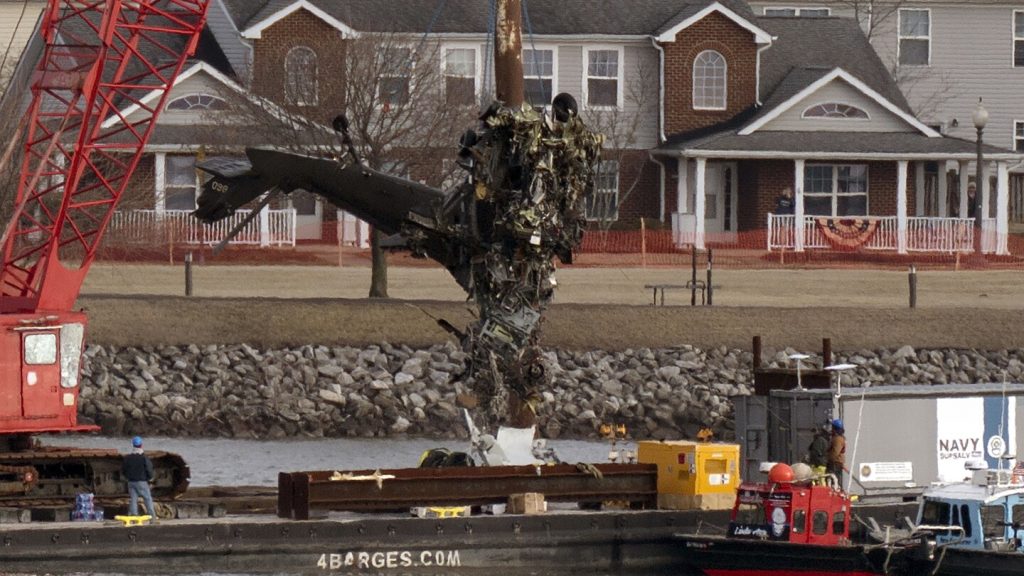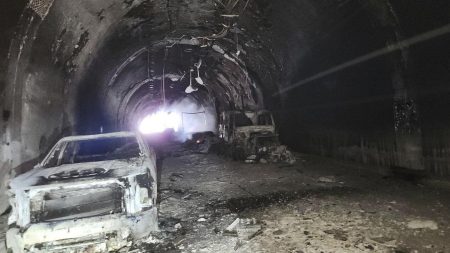Ongoing Search Efforts for Debris in Potomac River
The tragic collision between a passenger jet and an Army helicopter near Washington, D.C., has left the nation in mourning. Crews are working tirelessly to recover debris from the crash, which occurred on January 29 and claimed the lives of all 67 people on board. In a recent update, the National Transportation Safety Board (NTSB) revealed that a specialized plane equipped with laser scanning technology has been deployed to scan the bottom of the Potomac River. This advanced technology is being used to map the riverbed and locate smaller debris that may have been missed in earlier searches. While large pieces of the jetliner and helicopter, along with the remains of all victims, have already been recovered, the process of identifying and retrieving smaller fragments is expected to take several more days.
The operation is part of a meticulous effort to ensure that every piece of the aircraft is accounted for, as these fragments will play a critical role in determining the cause of the collision. Investigators are particularly interested in examining the debris for any markings that could provide insights into the angle and severity of the impact. The NTSB has emphasized that while significant progress has been made, the investigation is still in its early stages, and it may take time to piece together the events leading up to the tragedy.
The Role of Technology in the Search and Investigation
The use of a plane operated by the National Oceanic and Atmospheric Administration (NOAA) marks a significant step in the recovery process. Equipped with laser scanning technology, the aircraft has been flying at low altitudes over the crash site to penetrate the river’s surface and create a detailed map of the riverbed. This technology is invaluable in identifying submerged debris that may not be visible to the naked eye. The data collected will be used not only to locate remaining fragments but also to aid investigators in reconstructing the crash.
In addition to the laser scanning technology, the NTSB is leveraging other resources to support the investigation. The agency has confirmed that all major pieces of the two aircraft have been found, but smaller debris, such as wiring, instruments, and other components, are still being sought. These smaller pieces are crucial for understanding the mechanical and operational conditions of the aircraft at the time of the collision.
Investigating the Cause of the Collision
As the recovery efforts continue, the NTSB is also focusing on uncovering the circumstances that led to this tragic event. The collision between the Army helicopter and the American Airlines flight occurred in a highly trafficked airspace, raising questions about air traffic control systems, communication protocols, and the performance of surveillance technology.
One key area of investigation is the helicopter’s advanced surveillance system, which transmits its location and other data to air traffic control and nearby aircraft. According to Texas Republican Sen. Ted Cruz, NTSB officials informed Congress that this system was turned off at the time of the collision. This revelation has sparked further questions about why the technology was not active and whether its deactivation contributed to the crash.
Another critical aspect of the investigation is the altitude at which the helicopter was flying. Preliminary reports suggest that the helicopter may have been operating above its authorized flight ceiling of 200 feet. Investigators are working to confirm this and assess whether it may have played a role in the collision. To do this, they will need to thoroughly examine the wreckage of the Black Hawk helicopter, which has already been recovered.
President Trump Weighs In on Air Traffic Control Systems
The tragedy has also sparked a broader conversation about the state of U.S. air traffic control systems. President Donald Trump addressed the issue on Thursday, blaming the collision on what he described as an “obsolete” computer system used by air traffic controllers. The President vowed to modernize the system, emphasizing the need for updated infrastructure to prevent similar incidents in the future.
While the NTSB has not yet determined the exact cause of the collision, the President’s comments highlight the growing urgency to address outdated technologies in the aviation sector. The investigation will likely shed light on whether air traffic control systems were a contributing factor, but for now, the focus remains on recovering debris and conducting a thorough analysis of the wreckage.
A Tragic Reminder of Aviation Risks
The collision over Washington, D.C., is the deadliest aviation disaster in the U.S. since November 12, 2001, when a jet crashed into a New York City neighborhood just after takeoff, killing 260 people on board and five on the ground. This recent tragedy serves as a stark reminder of the risks and complexities involved in aviation, even as safety standards and technologies continue to improve.
The loss of 67 lives has left families and communities grieving, and the nation is coming together to honor the memories of the victims. As the investigation unfolds, the hope is that the lessons learned from this tragedy will help prevent similar incidents in the future. The NTSB’s work is not only about uncovering the cause of the collision but also about ensuring that the aviation industry becomes safer for everyone.
Moving Forward: Lessons and Legacy
The recovery efforts in the Potomac River are expected to conclude in about a week, but the impact of this tragedy will be felt for much longer. The NTSB’s investigation will be instrumental in determining the root causes of the collision and identifying steps that can be taken to prevent such incidents in the future. Whether it involves upgrading air traffic control systems, improving surveillance technologies, or reevaluating flight protocols, the findings of this investigation will play a pivotal role in shaping the future of aviation safety.
As the nation mourns the lives lost, it is also important to recognize the dedication of the crews and investigators working tirelessly to uncover the truth. Their efforts are not only about bringing closure to the families of the victims but also about ensuring that the legacy of this tragedy is one of resilience, learning, and progress. The road ahead will be long, but the collective commitment to safety and accountability will guide the way forward.












